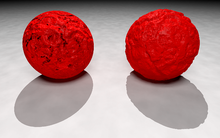File:Bump map vs isosurface3.png

Original file (1,680 × 1,050 pixels, file size: 1.14 MB, MIME type: image/png)
| This is a file from the Wikimedia Commons. Information from its description page there is shown below. Commons is a freely licensed media file repository. You can help. |
Summary
| DescriptionBump map vs isosurface3.png |
English: Raytraced image illustrating the limitations of w:bump mapping created with w:POV-Ray.
On the left, a sphere is given an apparently bumpy surface by using POV-Ray's internal "agate" function to create a bump map (the agate function defines a value for each point in 3D space). This changes the way light is calculated to reflect from the surface of the sphere without actually changing the sphere's size or shape. The outline of the sphere and the shadow on the ground are therefore those of a perfect, non-bumpy sphere. An unrealistic hard shadow is also visible on the surface of the sphere, about a third of the way from the top. On the right, a sphere with a bumpy surface is actually modelled by calculating an w:isosurface for a sphere function modified by the agate function (the agate function is subtracted from a function defining a sphere, x2+y2+z2-Radius2, and all points in space where this sum is zero form the surface of the resulting object). This results in an actual modification in the size and shape of the sphere. The outline of the sphere and the shadow on the ground are therefore also changed. The shadowing on the surface of the sphere is also more realistic. Other raytracing techiniques used in an attempt to increase realism include w:Radiosity (3D computer graphics) and a simulated finite w:Depth of field. Possible wikipedia image text: In 3D computer graphics, bumps, wrinkles and dents on the surface of an object can be simulated by using bump mapping. A bump map changes the way the surface appears to reflect or refract light and can increase the realism of computer-generated images without significantly increasing render times. The technique is limited in that it does not actually modify the shape of the underlying object. On the left, a mathematical function defining a bump map simulates a crumbling surface on a sphere, but the object's outline and shadow remain those of a perfect sphere. On the right, the same function is used to modify the surface of a sphere by generating an isosurface. This actually models a sphere with a bumpy surface with the result that both its outline and its shadow are rendered realistically. POV-Ray code: #version 3.6;
#declare rad=1;
global_settings {
assumed_gamma 1.0
ambient_light 0
#if (rad)
radiosity {
pretrace_start 0.08 // start pretrace at this size
pretrace_end 0.04 // end pretrace at this size
count 35 // higher -> higher quality (1..1600) [35]
nearest_count 5 // higher -> higher quality (1..10) [5]
error_bound 1.8 // higher -> smoother, less accurate [1.8]
recursion_limit 3 // how much interreflections are calculated (1..5+) [3]
low_error_factor .5 // reduce error_bound during last pretrace step
gray_threshold 0.0 // increase for weakening colors (0..1) [0]
minimum_reuse 0.015 // reuse of old radiosity samples [0.015]
brightness .4 // brightness of radiosity effects (0..1) [1]
adc_bailout 0.01/2
normal on // take surface normals into account [off]
media off // take media into account [off]
always_sample on // turn sampling in final trace off [on]
max_sample 1.0 // maximum brightness of samples
}
#end
}
#if (rad)
fog{
fog_type 1
distance 9
rgb 0
turbulence 5}
#end
// ----------------------------------------
camera {
location <0.0, 1.5, -4>
direction z
right x*image_width/image_height
look_at <0.0, 0, -1.4>
// focal blur camera
#if(rad)
aperture .2
blur_samples 125
focal_point <0,0,-.9>
confidence 0.99
variance 1/20000
#end
}
light_source { <6, 2.5, -6> color rgb <1, 1, 1>*.3
area_light <1,0,0>,<0,0,1> #if(rad)2,2 #else 2,2 #end orient circular
}
light_source { <-9, 7.5, -6> color rgb <1, 1, 1>*.5
area_light <3,0,0>,<0,0,3> #if(rad)5,5 #else 2,2 #end orient circular
}
light_source { <0, 100, 80> color rgb <1, 1, 1> area_light <1,0,0>,<0,0,1> #if(rad)2,2 #else 2,2 #end orient circular}
// ----------------------------------------
box{<-35,-2,-3>,<35,-1,38>
pigment { color rgb 1 }
finish {ambient 0}
}
#declare mytex=texture{pigment { bozo
colour_map{
[0 colour rgb <.3,.1,.05> ]
[0.25 colour rgb <.32,.08,.06> ]
[0.5 colour rgb <.3,.1,.05> ]
[.75 colour rgb <.28,.12,.04> ]
[1 colour rgb <.3,.1,.05> ]
}
scale .15
turbulence 2.75
}
finish{ specular 0.1 roughness .0075 diffuse .70 ambient 0 reflection 0.0}}
#include "functions.inc"
#declare function2=function{f_agate(x/.5,y/.5,z/.5)*.1}
#declare function3=function(x,y,z,Radius,xoff,yoff,zoff){pow(x-xoff,2)+pow(y-yoff,2)+pow(z-zoff,2)-pow(Radius,2)}
#declare ball=
isosurface {
function {function3(x,y,z,1,0,0,0)-function2(x,y,z)*1} //.71
max_gradient 8
contained_by { sphere { 0, 1.5 } }
texture {mytex}
translate x*1.5
}
object{ball translate <0,0,0> }
sphere { 0, 1
texture {
mytex
//normal{bozo scale .5}
normal {function {function2(x,y,z)*10*.25} accuracy .0002 bump_size 1.5}
}
rotate -y*32
translate -x*1.5
}
|
| Date | |
| Source | Own work |
| Author | GDallimore |
| Other versions |
  |
Licensing
| Public domainPublic domainfalsefalse |
| I, the copyright holder of this work, release this work into the public domain. This applies worldwide. In some countries this may not be legally possible; if so: I grant anyone the right to use this work for any purpose, without any conditions, unless such conditions are required by law. |
Captions
Items portrayed in this file
depicts
4 January 2011
image/png
b36a6727404645294722d7db0a4c319cc5b3f238
1,192,181 byte
1,050 pixel
1,680 pixel
File history
Click on a date/time to view the file as it appeared at that time.
| Date/Time | Thumbnail | Dimensions | User | Comment | |
|---|---|---|---|---|---|
| current | 20:04, 4 January 2011 |  | 1,680 × 1,050 (1.14 MB) | GDallimore | {{Information |Description={{en|1={{Created with Persistence of Vision}} Raytraced image illustrating the limitations of w:bump mapping created with w:POV-Ray. On the left, a sphere is given an apparently bumpy surface by using POV-Ray's interna |
File usage
The following 2 pages use this file:
